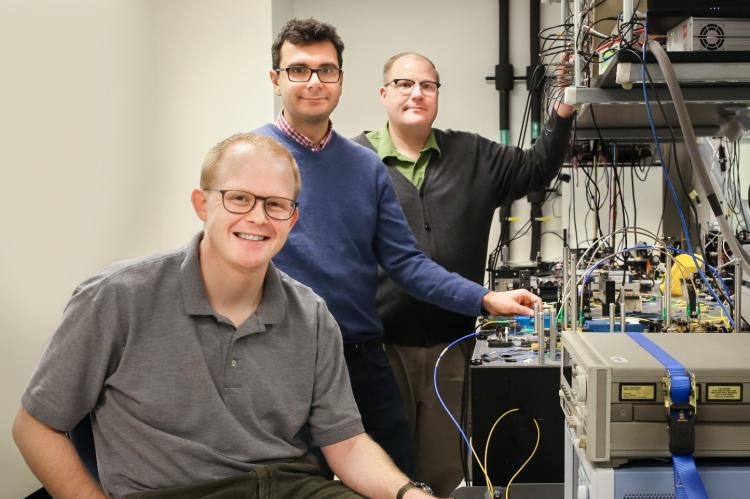Feb 19 2018
Researchers led by the Department of Energy’s Oak Ridge National Laboratory have demonstrated a new technique for splitting light beams into their frequency modes. The team can then select the frequencies they prefer to work with and encode photons with quantum information. Their research could encourage progress in quantum information processing and distributed quantum computing.
 Joseph Lukens, Pavel Lougovski and Nicholas Peters (from left), researchers with ORNL’s Quantum Information Science Group, are examining methods for encoding photons with quantum information that are compatible with the existing telecommunications infrastructure and that incorporate off-the-shelf components. Credit: Genevieve Martin/Oak Ridge National Laboratory, U.S. Department of Energy
Joseph Lukens, Pavel Lougovski and Nicholas Peters (from left), researchers with ORNL’s Quantum Information Science Group, are examining methods for encoding photons with quantum information that are compatible with the existing telecommunications infrastructure and that incorporate off-the-shelf components. Credit: Genevieve Martin/Oak Ridge National Laboratory, U.S. Department of Energy
The researcher’s findings were published in Physical Review Letters.
The frequency of light establishes its color. When the frequencies are divided, as in a rainbow, each color photon can be encoded with quantum information, delivered in units called qubits. Qubits are similar to but diverse from classical bits, which have a value of either 0 or 1, because qubits are encoded with values of both 0 and 1 simultaneously.
The team compares quantum information processing to stepping into a hallway and being able to walk both ways, but in classical computing only one path is possible.
The team’s fresh approach—featuring the first display of a frequency tritter, an instrument that splits light into three frequencies—returned experimental results that corresponded to their predictions and revealed that many quantum information processing operations can be worked concurrently without increasing error. The quantum system performed as anticipated under progressively complex conditions without degrading the encoded information.
Under our experimental conditions, we got a factor 10 better than typical error rates. This establishes our method as a frontrunner for high-dimensional frequency-based quantum information processing.
Nicholas Peters, Quantum Communications team lead, ORNL’s Quantum Information Science Group
Photons can convey quantum information in superpositions—where photons concurrently have many bit values—and the presence of two quantum systems in superposition can result in entanglement, a main resource in quantum computing.
Entanglement improves the number of calculations a quantum computer could work, and the team’s concentration on developing more multifaceted frequency states aims to make quantum simulations more robust and efficient. The researchers’ technique is also remarkable because it demonstrates the Hadamard gate, one of the elemental circuits needed for universal quantum computing.
“We were able to demonstrate extremely high-fidelity results right off the bat, which is very impressive for the optics approach,” said Pavel Lougovski, the project’s principal investigator. “We are carving out a subfield here at ORNL with our frequency-based encoding work.”
The technique leverages extensively available telecommunications technology with off-the-shelf components while producing high-fidelity results. Efforts to create quantum repeaters, which extend the distance quantum information can be conveyed between physically separated computers, will profit from this research.
The fact that our method is telecom network-compatible is a big advantage. We could perform quantum operations on telecom networks if needed.
Pavel Lougovski
Peters added that their project shows that unused fiber-optic bandwidth could be harnessed to decrease computational time by working operations in parallel.
“Our work uses frequency’s main advantage—stability—to get very high fidelity and then do controlled frequency jumping when we want it,” said Wigner Fellow Joseph Lukens, who led the ORNL experiment. The team has experimentally revealed that quantum systems can be transformed to yield desired outputs.
The researchers recommend their technique could be paired with current beam-splitting technology, exploiting the strengths of both and drawing the scientific community closer to complete use of frequency-based photonic quantum information processing.
Peters, Lougovski and Lukens, all physicists with ORNL’s Quantum Information Science Group, partnered with graduate student Hsuan-Hao Lu, professor Andrew Weiner, and colleagues at Purdue University. The researchers published the theory for their experiments in Optica in January 2017.
This study is supported by ORNL’s Laboratory Directed Research and Development program and the National Science Foundation.